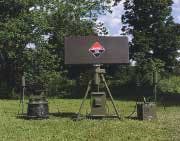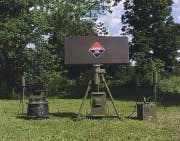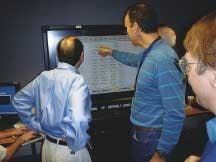Enabling technologies for military and aerospace electronics designers
Board products
Lockheed Martin chooses Mercury for ground-mobile air-defense radar
Designers at Lockheed Martin Maritime Systems & Sensors (MS2) division in Syracuse, N.Y., needed a multicomputer system for the Portable Search and Target Acquisition Radar-Extended Range (PSTAR-ER) program.
They picked the RACE++ rugged, conduction-cooled multicomputer from Mercury Computer Systems, Chelmsford, Mass. The initial order is for $1.4 million.
PSTAR-ER is a lightweight, man-portable, air-defense radar suited for battlefield deployment, providing alerts for associated air-defense weapon systems in support of ground-troop offensive or defensive missions. The new Mercury computers add the extra processing that is needed to extend the radar's detection range from about 12 to 18 miles.
The system is an upgrade to Lockheed Martin's existing PSTAR radar, which was originally developed for the U.S. Army (AN/PPQ-2) and is deployed in five countries. The radar system, designed for a wide range of environments, has detection capability against fixed and rotary-wing targets, while operating effectively in an electronic-jamming environment.
"Incorporating Mercury's COTS (commercial off-the-shelf) technology into the PSTAR-ER enables much greater processing while fitting into the same small package," said Paul Garvey, PSTAR product line manager, MS2. "The open-system architecture allows the use of other complementary COTS products currently on the market as well." For more information, see http://ness.external.lmco.com/ news/03may29syracuse.html or www.mc.com.
Displays
NASA chooses SMART touch screen for data analysis on Mars Rover mission
Planners at the U.S. National Aeronautic and Space Administration (NASA) needed a touch-panel display for planning and analysis of data in their Mars Exploration Rover (MER) mission.
They found the best solution with SMART Technologies Inc. in Calgary, Alberta, Canada.
NASA uses the SMART Board for Flat-Panel Displays to create a network of MERBoards, or a large, touch-enabled, plasma-display system. Engineers have installed 17 MERBoards at NASA's Jet Propulsion Laboratory (JPL) in Pasadena, Calif., and five more at NASA's Ames Research Center in Mountain View, Calif.
The SMART Board interactive overlay gives MERBoards touch control, making it possible to display and write information on one large plasma display and to share it over multiple displays.
"The touch screen brings a whole collaborative element to the workpractice," said Ted Shab, NASA's MERBoard deputy project manager. "In the context of the SOLTree tool — a flowchart representation of the long-term objectives of the rover — users can come up to the screen and interactively work with the application while they view it together. The touch screen definitely encourages a more collaborative work practice than if they were working on it one at a time at a keyboard."
MERBoards are an adaptation of IBM's BlueBoards, which incorporate SMART Board for Flat-Panel Displays interactive overlays and were designed by IBM's Almaden Research Center.
Data storage
Airbus chooses L-3 Aviation for flight-data and cockpit-voice recorders
Designers of the Airbus A380 airplane in Toulouse, France, needed flight-data recorders and cockpit-voice recorders. They chose L-3 Communications Aviation Recorders of Sarasota, Fla., to supply them.
The A380 is the world's only large double-deck airplane, designed to seat 555 passengers in a typical three-class configuration. It is scheduled to enter airline service in 2006.
L-3 Aviation Recorders' A380 Flight Data Recorder is an accident-survivable unit capable of recording 25 hours of high-data rate flight and maintenance data in a lightweight, compact memory unit.
And the A380 Cockpit Voice Recorder is capable of recording two hours of high-quality voice communication and ambient cockpit sounds in an accident-survivable memory unit identical to the flight-data recorder.
In addition to voice, the cockpit-voice recorder will record digital data messages received from aircraft ground-flight controllers using controller-pilot data link communications. As an integral part of the aircraft's enhanced maintenance system, the recorders will provide constant updates on its operational status to the central maintenance computer.
L-3 Aviation Recorders products will now be available for the entire fleet of Airbus aircraft, including the A340, A330, A320, A319, A318, A310, and A300.
For more information, see www. L-3ar.com or www.L-3Com.com.
Components
Army chooses American Technology Corp. for nonlethal weapon
Designers of the U.S. Army's new light-and-fast Stryker vehicle needed a nonlethal weapon to help enforce crowd control and checkpoints in Iraq. They found an answer in the Long Range Acoustic Device (LRAD), a directed acoustic tool from American Technology Corporation (ATC).
Army planners awarded ATC a $485,000 contract to deliver LRADs and vehicle mounts to the 3rd Battalion, 2nd Infantry Stryker Brigade Combat Team, now deployed in Iraq.
The LRAD is a long-range hailing and warning device designed to communicate with authority and intelligibility. A soldier can use LRAD to issue a verbal instruction in excess of 300 yards via a focused beam and follow up with a harsh warning tone to influence behavior.
"With the increased insurgency in Iraq, LRAD provides a new tool to focus
highly intelligible and authoritative communication to reduce tension, effect peaceful outcomes, and define potentially hostile situations at safer distances," said Carl Gruenler, ATC vice president for military and government operations. "Mounting LRADs on armored military vehicles is a significant expansion over previous applications. We strongly believe LRAD use can increase situational awareness and save lives on both sides of the device."
The Stryker is the first new military vehicle to enter Army service since the Abrams tank in the 1980s. It is a ruggedized, lightweight, wheeled fighting vehicle that fits in the Army's vehicle lineup roughly between the Humvee and the Bradley Fighting Vehicle. For more information, see www.atcsd.com.
Software
Calgary airport picks Rannoch to track planes
Planners at Calgary International Airport in Canada needed a way to track aircraft operations on the runways. They solved the problem with software from Rannoch Corp., Alexandria, Va.
Nav Canada awarded two contracts to Rannoch for its AirScene software, used for Advanced Surface Movement Guidance and Control Systems (A-SMGCS), Automatic Dependent Surveillance-Broadcast (ADS-B) equipment, and aircraft geometric height-measurement-processing software.
The contracts include a multisensor (multilateration) surveillance system that will track aircraft operations on the surface areas of the airport as well as ADS-B processing software for several ground receiver systems, used to track surface, terminal, and en route aircraft operations.
"We are pleased to continue our very successful partnership with Nav Canada, one of the most efficient and innovative air-traffic-services providers in the world," said Bennett Cohen, a senior program manager at Rannoch. "Nav Canada has pioneered and embraced the use of new surveillance and automation technologies for surface, terminal, en route, and oceanic airspace, which has confirmed the organization as a leader in air-traffic services.
"Nav Canada fully understands that effective air-traffic and airport management needs to be seamless and gate-to-gate," Cohen continued, "and we are proud to be a part of Nav Canada's plans for 21st century air-traffic management." For information, see www.rannoch.com or www.airscene.com.
Sensors
Tampa Airport picks FKI Logistex and L-3 for baggage screening
Planners at Skanska USA Building Inc. needed a system to sort and screen baggage for Tampa International Airport. They found a solution with FKI Logistex.
They awarded a $15 million contract to the FKI Logistex Baggage Handling Team to create an in-line hold-and-baggage-screening project.
This contract follows the team's 2003 installation of dual security-screening loops and a state-of-the-art baggage-handling transport-and-pier sortation system at the same airport.
The new project includes the design and implementation of two baggage-screening loops in the airport's main passenger terminal. Each loop will contain three in-line eXaminer(r) 3DX(tm) 6000 Explosives Detection Systems (EDS) from L-3 Communications. The 3DX 6000s will perform X-ray baggage screening for passengers departing through the airport's satellite Airside E and F gate terminals.
All sorting and diagnostics software and equipment required to control the new systems will be implemented by the FKI Logistex Baggage Handling Team. This will include a stand-alone sort allocation computer (SAC) and a maintenance diagnostics system (MDS). For more information, see www.baggagehandling.com or www.fkilogistex.com.





